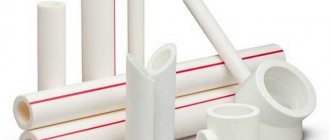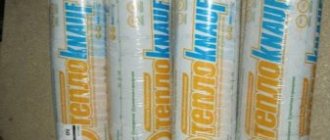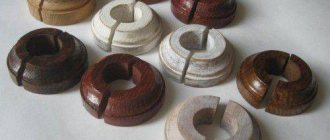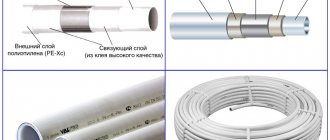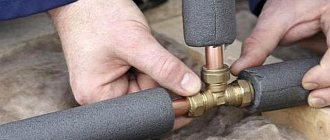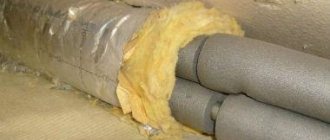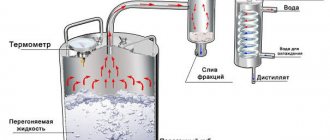Hello friends!
Water supply in an apartment building, private house or country cottage is a common occurrence; water should be available at any time of the year. However, temperature fluctuations can make significant adjustments to the water supply process. Apartment owners think little about how the water supply is organized, and owners of private houses are forced to take steps on their own to ensure that the water in the pipes does not freeze in winter.
At the same time, we note that frost does not spare either steel or plastic pipes. The only way to keep water in liquid form and prevent damage to the water supply system is to fully insulate the water pipes. After all, unlike a heating pipe system, there is no warm medium.
Due to the fact that thermal insulation is carried out on your own site, we are not talking about an industrial scale of work, which means it makes sense to study how to insulate water pipes with your own hands.
Methods for insulating water pipes outdoors (in the ground)
- increasing pressure in the water supply system;
- cable for heating a water pipe;
- thermal insulation for water supply pipes.
1. Creating high pressure in the water supply system
The water pipe will not freeze because the water will move at high speed. To implement this method, a pump is used to increase the pressure in the water supply system or a receiver that cuts into the pipe directly next to the pump.
Heating cable for water supply
Cable power 10-15 W (average price – 15 USD/m.p.).
Excellent for heating pipes in the ground when they are placed at a shallow depth. According to the rules, it is not advisable to place any communications in the soil below the soil freezing level. There are situations in which this requirement is ignored. In this case, simple insulation of pipes will not give the desired result, because... the pipeline will in fact be located in water (in a humid environment that freezes in winter). Most of the insulation materials are not suitable for this mode of operation and do not provide proper thermal insulation.
Using a cable to heat the water supply makes it possible to lay pipes at a depth of up to 500 mm.
Heating cable for water pipe
The heating cable for insulating water pipes is wound along the pipe or around it with a given pitch. The pitch is determined by the power of the cable. The lower the power, the smaller the step. Methods for laying the heating cable are shown in the diagram.
Wiring diagram for installing a cable for heating a water pipe
Craftsmen and users note that insulating a water supply system by heating the pipe with a cable is the most reliable method for protecting pipes laid in the ground freezing zone.
Cable heating makes it possible to avoid freezing of water in the pipe, and, equally important, to quickly defrost frozen pipes. Such a need may arise at a dacha if it is intended for seasonal living. In this case, you can quickly prepare the pipeline for operation, because under natural conditions you can wait until May for complete defrosting (when laying pipes at the level of soil freezing). The cable is located both inside and outside the water supply pipe.
Application of thermal insulation materials for pipes
This is the most cost-effective and easiest insulation method from the point of view of independent implementation. Let's look at it in more detail. Let's start with the best way to insulate a water supply system, what materials can be better used depending on specific conditions.
Oil pipeline insulation
Trunk pipelines transporting liquid fuels must meet strict requirements regarding thermal insulation and fire resistance. The required level of protection is provided by:
- PPU. Foamed polymer reliably protects pipes and their contents from temperature fluctuations. The material has a porous structure, but is quite light and does not load the pipes. Combines low vapor permeability and thermal conductivity with fire resistance, resistance to temperature changes and chemicals.
- Foamed rubber. Another polymer with positive performance properties makes installation easier and faster. Due to its plasticity, it is convenient for insulating curved sections of oil pipes. Protects metal from corrosion and destruction under the influence of an aggressive environment.
- Liquid insulation with special paints and varnishes. Protect underground pipes from water and salts dissolved in the soil. Paints for oil pipeline insulation have high electrical insulating properties and increased resistance to chemicals and overheating. Liquid insulators are applied by spraying or painting with brushes; the final layer is very thin and does not create unnecessary load on the system.
Thermal insulation for water supply pipes
It is not difficult to get confused in the wide range of thermal insulation materials. To choose the best option, you need, at a minimum, to know the main types and types, key characteristics and features.
Thermal insulation of water pipes is carried out with various insulation materials, which are grouped below (in the form of a classification) according to the principle of unity of insulation technology.
Materials for insulating water pipes
Types, types, varieties and rules for choosing pipe insulation.
Rigid insulation
This category includes polystyrene foam, polystyrene foam (2560-3200 rubles/cube) and Penoplex (3500-5000 rubles/cube), thermal insulation properties and price depend on density.
Polystyrene foam is an excellent insulator and has a relatively low cost (compared to other materials). However, it is quite difficult to insulate a round pipe with a rigid insulation board. To insulate pipes, special shells (hard boxes) are used - shells in which pipes are placed, and the space is filled with soft insulation.
Laying water pipes in a foam box
Roll insulation
This segment includes: polyethylene (as an additional material), foil penofol (50-56 rubles/sq.m.), mineral wool (70-75 rubles/sq.m.) and glass wool (110-125 rubles/sq.m.) ), furniture foam rubber (250-850 rubles/sq.m. depending on thickness).
Insulating water supply pipes with rolled thermal insulation is also fraught with difficulties, which lie in the hygroscopicity of the material. Those. insulation loses its properties when exposed to moisture, which means it has a narrower scope of application, or needs additional protection. Plus, you need to think about how to attach the insulation to the pipe.
Basalt heat-insulating mats and foam rubber for insulation of water pipes
Segmental (shell) insulation
Pipe insulation casing is the most progressive option for pipeline thermal insulation. The shell for insulating the water pipe ensures maximum tightness and, as a result, creates a reliable thermal insulation layer.
There are types of segmental insulation:
Polystyrene foam shells for insulating water pipes are rigid (thermal insulating casing for pipes is a shell made of polystyrene foam (PPU) or foam plastic. Price from 190 rubles/m.p., depends on the thickness and diameter of the cylinder);
Sprayed insulation (PPU)
The peculiarity of insulation by spraying polyurethane foam is that thermal insulation is applied to the surface of the pipe, ensuring 100% tightness (the cost of components for polyurethane foam filling starts from 3.5 euros per kg).
The number of components is determined by the thickness of the fill; work is paid additionally). On average, the cost of insulation with sprayed polyurethane foam is 15-20 dollars/m.p.
Sprayed insulation also includes heat-insulating paint for pipes. You can apply it yourself, because... Thermal paint is sold in aerosol cans.
A layer of paint of 20 mm. replaces 50 mm of basalt wool insulation. In addition, this is the only material that is not susceptible to damage from rodents.
Insulation of water pipes by spraying polyurethane foam (PPU) Water pipe insulated with polyurethane foam (PPU)
When choosing thermal insulation material for insulating water supply pipes, you need to take into account the following factors:
- pipeline installation location. Insulation of pipes laid on the ground and located underground is carried out in different ways, even when using the same materials (it is also important to take into account whether the pipes are laid before or below the freezing level);
- frequency of pipeline operation. For example, in a country house that is not intended for permanent residence, it is enough to simply avoid a pipe rupture. To do this, a receiver is installed or the water supply is insulated with a cable. But in a private house it is necessary to ensure a year-round water supply. Here you need to approach the choice of insulation more carefully;
- thermal conductivity indicator of pipes (plastic, metal);
- resistance to moisture, combustion, biological activity, ultraviolet radiation, etc. determines the need to protect the insulation from these factors;
- ease of installation;
- price;
- life time.
Features of CPI coating
Cement-sand insulation initially provides resistance to mechanical damage and shock. Chemical protection is activated the first time the transported substance passes through the highway. The fluid flow affects the CPI. The smallest grains of insulation are pressed and spread over the steel surface, filling the pores on the walls of the pipeline. The process is accompanied by the formation of calcium hydroxide, which completely suppresses corrosion.
The thickness of the insulating layer is 4-16 mm along the length of the pipe and from 3 mm at the welds. The compressive strength of the CPI coating is not lower than 445 MPa. The only sources of metal destruction are aging and mechanical damage.
How to insulate a water pipe with your own hands
The location of the pipes is another important factor that must be taken into account when choosing insulation. Indeed, depending on where the pipes are located (in the ground, basement, cold attic, unheated room), the temperature and humidity conditions are determined, as well as the ease of installation of the insulation and the need for its additional protection.
Insulation of water pipes on the street
Water pipes are rarely laid by air or on the soil surface. Rather, in this case, the part of the pipeline that runs directly under the house or at the junction of the pipe with the pump, meter, or inside the distribution well needs insulation.
The specificity of insulation in this case is such that the pipe is insulated with any insulation that is capable of ensuring a sufficient tightness of the fit and is not exposed to moisture.
As a rule, the thickness of the insulation intended for above-ground insulation of pipes is higher than for underground insulation. At this stage, it is important not only to insulate the pipe, but also to ensure protection of the thermal insulation material, in particular from getting wet.
Insulation of water pipes in the ground
Such insulation will be needed only if the pipes are laid above the soil freezing level. To insulate a pipeline in the ground, you can use any material, including rigid insulation.
It is worth noting that the insulation of external water supply does not end with the installation of insulation. It is important to protect the insulation from getting wet. To do this, a film, roofing material is wound over the main thermal insulation material, or a plastic box is installed.
General information
And under no circumstances should the water inside the structure be allowed to freeze, otherwise it can rupture and damage the entire plumbing system.
There are two weak points in a home plumbing system.
- The location of the pipeline on the street under a layer of earth.
- The pipeline is located in an unheated room.
If it is easier to insulate the water supply in a private house that is located indoors, then the water supply that is laid outside requires a more thoughtful approach. Basically, it all depends on the quality of the insulation used.
A good insulation for water supply should have the following characteristics:
- low thermal conductivity;
- durability;
- ease of installation;
- resistance to aggressive environments;
- must withstand the operating temperature of the environment;
- fire safety and tightness;
- low price with the possibility of repeated use
Based on these characteristics, the optimal thermal insulation for water supply in a private house is selected. Today there are a large number of insulation materials. Below we will analyze some of them.
How to install a heating cable for heating pipes
For installation, prepare: foil tape, thermal insulation material, heating cable (power 20 W per linear meter).
Installing a heating cable on top and inside a water pipe
Technology for insulating water pipes with cable:
- the pipe along its entire length (from the well/well to the house) is glued with foil tape;
- The heating cable is laid in a convenient way with the same pitch. For a 20 W cable, a pitch of 100-150 mm will be optimal. For a less powerful cable, the pitch is reduced. The most convenient way to lay the cable is to wrap the pipe in a spiral;
- the cable is fixed with foil tape;
- Insulation is installed on the pipe. Pipes made of foamed polymers, basalt cylinders or polyurethane foam shells are placed on the pipe. In this case, it is necessary to ensure that the diameter of the pipe corresponds to the internal diameter of the segmental insulation. Before starting work, roll insulation is cut into strips, which are wrapped around the pipe and secured with clamps or wire. Their task is to hold the insulation in a given position.
- the insulation is fixed to the pipe with tape (plumbing tape). The tape is wrapped very tightly. The main task of the winding is waterproofing, i.e. prevent groundwater from entering the insulation;
- additionally insulate the pipe at the point where it reaches the soil surface. The following options are offered: additional winding with insulation or arrangement of a box in which the insulation will be placed.
Installation of cable for heating pipes
Regardless of the insulation method, it makes sense to choose only high-quality materials and install them according to the instructions. Of course, this affects the budget of the event, but expenses of this kind pay off in the future. And a frosty winter will not bring unpleasant surprises in the form of a lack of water due to freezing in pipes or a rupture in the water supply system.
Source: moydomik.ne
Insulation materials
It is difficult to imagine comfortable living in a house without a constant water supply. However, many owners of their own houses and cottages face freezing water pipes in winter.
Frost does not spare either high-quality galvanized steel pipes or metal-plastic products from the best manufacturers, tearing all pipes equally harshly. You can avoid such a sad outcome if you promptly insulate the water pipes yourself.
The need to insulate the water supply
So, you understand the need to insulate the water supply in your home. Considering that there are not kilometers of pipes on the site, industrial-scale work will not be needed. Remember that the depth of the pipes should be up to half a meter.
Of course, the higher this indicator, the lower the risks that you will be left without water in winter. But even if you met this parameter when installing the water supply system, it is best to insulate it additionally.
Particular attention should be paid to the procedure for insulating water pipes in unheated rooms and outdoors, since these places are the most vulnerable to freezing.
If it is not so difficult to insulate the water supply inside the building, then the thermal insulation of pipes that are located on the street, especially in places where they come into contact with pumps, meters, as well as in distribution wells, will take more time and effort.
Materials for insulating water supply pipes
The time has long passed when water supply insulation was carried out using sweatshirts, cotton blankets and other improvised materials. Today there are many thermal insulation materials on sale.
That is why it is so important to be able to choose the right insulation and know what to pay attention to first. It is recommended to purchase material for pipe insulation based on its basic characteristics and ease of installation.
When choosing insulation, remember that it must meet the following requirements:
- have a low level of thermal conductivity and have good heat-saving properties;
- be durable and resistant to chemical and biological influences of environmental factors;
- have a minimum coefficient of water absorption (high water-repellent properties), since moisturizing the material significantly increases its thermal conductivity;
- work at high temperatures without losing its structure and its own physical properties.
Knowing the basic properties of insulation and the location of water pipes on a plot of land, you will be able to make the optimal choice of thermal insulator for insulating water pipes. It is mainly recommended to install them to insulate indoor water supply systems.
Let's look at what insulation materials are intended for insulating a water pipe:
- Glass wool. Fiberglass insulation is used primarily for insulating metal-plastic pipes. Popular brands include Ursa, Knauf and Isover fiberglass insulation. Glass wool is characterized by low density; when using this material for thermal insulation of pipes, it is recommended to install additional external insulators such as roofing felt or fiberglass. And this already promises you additional time and material costs.
- Basalt insulation. Insulation of this type is made in the form of cylinders, which makes it easy to install. For additional protection, the fiber is covered with a layer of roofing material, foil insulation or glassine. Despite the obvious advantages, the cost of such insulation is not very affordable.
- Expanded polystyrene. This insulation is the most popular material for self-insulating water pipes. Expanded polystyrene insulating shells are available with or without an outer covering. This heat-insulating material is designed for reusable use for insulating water pipes outdoors and indoors.
- Thermal insulation paint. This is a pasty mass of gray or white color, which is an innovative product in the domestic construction market. This composition is made on the basis of varnish or water with the addition of acrylic dispersion and fillers. It is best to apply heat-insulating paint using a sprayer. The thicker the paint layer you make, the higher the thermal insulation of the pipe will be. The paint can withstand high and low temperatures and has anti-corrosion properties. By the way, one layer of paint can replace polystyrene foam or glass wool.
Methods for insulating underground water pipes
Above we looked at the materials that are used to insulate pipes outside and inside the premises.
Some of the thermal insulators can be used underground. However, insulation in this way is not always easy and has many disadvantages. And therefore, it is worth paying attention to alternative methods of insulating water pipes in the ground when there is no need to lay pipes at a significant depth.
Let's take a brief look at these methods and find out how to properly insulate water pipes using them:
- Heating cable. Insulation occurs by heating the pipeline using a cable, the power of which is on average 10-20 W per linear meter, inside and outside the pipe. Since the winter season lasts only a few months, the insulation process is necessary exclusively during this time: the heating cable will only be turned on during such months. When using insulation, pipes do not need to be laid to a depth of 2 meters; it is enough to go only 50 centimeters deep.
- Insulation of pipes with air. In this case, you can use the materials listed above - polystyrene foam and basalt materials. The essence of the method is to insulate the pipes with air that comes from below, and to create a so-called “umbrella” from the cold air that comes from above. The pipe is placed in a cylindrical insulating material. The result is something like a “pipe within a pipe.”
- Insulation of water pipes using high pressure. As part of this technique, a receiver is inserted into the water supply system, where pressure is pumped into. This method will work best on submersible pumps, because they have the pressure necessary for the system (close to 5 atmospheres). But in order for the entire system to be under pressure, a check valve is installed immediately after the pump.
Polyurethane foam (PPU)
This material is no less effective insulation. To insulate the pipes, a polyurethane foam shell is used, which is a cylinder. It is made in two ways:
- By pouring liquid polyurethane under high pressure into a special mold:
- Manufactured using the “pipe in pipe” method. In this case, the material is poured into the cavity between two pipes - the inner one, with a smaller diameter, and the outer one, with a larger diameter.
The first option is suitable for insulating an independent pipeline. And the product of the second production method is pre-insulated pipes that are ready for laying a new pipeline.
- This is a completely new product that makes it possible not to think about additional insulation;
- In this case, the outer layer can be corrugated - flexible, which makes it possible to avoid the need to use rotary fittings, that is, the pipeline can be laid with a minimum number of connections;
- Both one- and two-pipe versions of such ready-made elements are produced;
- For laying a cold pipeline, structures with plastic pipes are better suited;
- For hot dishes, they produce more expensive options with metal pipes inside;
- Flexible pipes with pre-insulation are supplied in coils and have a length of up to 200 meters.
Regarding the PU shell, it has the following advantages:
- Heat loss is reduced by almost 40%;
- The installation of the elements is so simple that it allows you to independently insulate several hundred meters of pipeline in a day;
- This also indicates the speed of installation;
- The material is environmentally friendly;
- The insulation can be reused an unlimited number of times;
- The service life reaches 30 years.
Among the disadvantages is the inability to use the material at temperatures above 120°C. A great convenience is the presence of shaped segments, such as tees, elbows and branches. The two shell fragments are connected to each other using a special coupling, which makes the thermal insulation airtight and prevents the formation of cold bridges.
differs in coating material,
- Uncoated polyurethane foam is the most affordable, but can only be used for insulating pipes located, for example, in the basement, and then only if there is an additional casing. Either as an intermediate insulating layer;
- Shell with foil coating - the scope of application is not limited, and the material is characterized by increased strength;
- Shells coated with fiberglass can be used to insulate external sections of the pipeline, for example, places where pipes enter the house. It is distinguished by its resistance to ultraviolet radiation. At the same time, fiberglass is also distinguished by high hardness levels, which practically eliminates the possibility of mechanical damage;
- The glassine coating is resistant to direct sunlight, but is inferior to fiberglass in strength;
- Shell coated with reinforced aluminum foil (armofol) - used for insulation of pipelines operated under conditions of significant temperature changes;
- Galvanized steel coating is used to insulate pipelines running in air. Steel protects the shell from ultraviolet radiation, mechanical and biological influences, but at the same time is more affordable than a fiberglass coating.
The thickness of the shell is 20-80 mm and increases with increasing diameter. The length of one element does not exceed 1000 meters, taking into account the peculiarities of the manufacturing process.
Insulating the water supply with your own hands
All insulation materials that are used today for heating water pipes have exactly the same operating principle. The choice of specific thermal insulation will depend on the location of your plumbing and the water-repellent properties of the material.
Use of thermal insulation materials
Fiberglass is used to wrap the pipes, and then secure the wrapping with plastic tape. Next, it’s worth installing waterproofing - using roofing felt or other similar materials.
However, it is not recommended to insulate pipes located underground with fiberglass materials. Firstly, with this insulation method you will have to install two layers: the insulation itself and the casing, which consists of winding this heat insulator with some kind of waterproofing material. And this is quite long and tedious, which leads to an increase in the cost of insulating the water supply system.
Since the density of such heat-insulating materials is low, the thickness of the insulation when backfilling the trench will be disrupted in height, that is, the material will simply shrink under the weight of the soil, and this process can even continue for more than one season. As a result, the thickness of the insulation will not be enough to create high-quality insulation of the underground water supply.
If you backfill pipes using layer-by-layer compaction, this will only speed up the process. If the depth of the water supply system is insufficient, after prolonged autumn rains, surface water will most likely reach the heat insulator through loose soil (after backfilling), and it is unlikely to have time to dry out by winter.
Thermal insulation shells, made of basalt fiber or expanded polystyrene, are installed quickly and easily. Polystyrene foam halves of a certain diameter are placed on the water pipe with an offset of 100 - 200 millimeters relative to each other, first secured with tape.
An offset relative to each other is required for “overlapping”, which reaches 10 - 20 centimeters. To insulate corners, nodes and turns of the system, it is customary to use shaped shells.
The advantages of this method of insulating polystyrene foam water supply pipes are that the water absorption rate in 24 hours reaches only 0.5 - 2.0% by volume, so the insulation does not get wet and does not collapse under the influence of moisture, like glass wool.
When backfilling a trench, polystyrene foam will not wrinkle or get wet when surface water penetrates the soil. The same insulation technique can also be used when passing a water supply through an unheated room.
Application of heating cable
Let's consider organizing heating of the water supply using a special cable. I would like to immediately make a reservation that this is not a cheap pleasure, although if you install the pipes yourself, you can save a lot.
There are two types of cable heating of water pipes. In the first case, the wire runs inside the pipe, but the installation procedure is quite complicated, and it will be very difficult for a non-specialist to cope with it.
In the second case, the wire passes over the pipe, but the power and its length are calculated before installing the heat-insulating material. It is much easier to install it yourself.
By the way, there are ready-made kits for sale for arranging a water supply system, consisting of a pipe with a built-in heating cable and thermal insulation material, or without a wire, but with a cable channel made for it.
If you use this method of heating pipes, then you do not have to bury the water supply 2 - 2.5 meters, 50 centimeters is enough. To do this, you will need the following materials: plumbing and foil tape, waterproof insulation, self-regulating cable for insulating water pipes, which has a power of at least 20 W per meter. In addition, the heating cable allows not only the pipes not to freeze, but also to quickly defrost them.
The process of insulating a water pipeline with a heating cable occurs in the following sequence:
- Along the pipe that runs to the house from the well, you need to glue foil tape in a spiral. It is not glued too tightly so that the wire holds when winding through the pipe.
- After this, it is necessary to lay the heating cable along a pre-prepared spiral in increments of 10 - 15 centimeters.
- You should also stick foil tape over the cable, which will secure the wire.
- The insulation needs to be cut lengthwise and wrapped around the pipe. At the same time, it is necessary to carefully monitor the coincidence of all seams between the wire and the insulation, which will help prevent the appearance of “cold bridges”.
- Next, you should take plumbing tape and wrap the entire pipe very tightly over the insulation material. Remember that wrapping with plumber's tape is mandatory, as it helps prevent groundwater from penetrating through existing gaps.
- After you have reached the places where the water supply system exits from the ground and enters the house, there is a need to use additional windings, which can be done in several ways: by additional insulation of cold water pipes using plastic film and by arranging a box frame around the pipes where it will be stuff insulation. The upper part of the box is also covered with a protective coating, for example, a wind- and moisture-proof film, sewn up after installation.
It is now increasingly common to install temperature data collection points along with the heating cable. It is enough to install 3-4 sensors on the highway so that you can monitor it manually or automatically.
For example, if the temperature drops below 5 degrees above zero, the system will turn on a voice alert and send a message to email or mobile phone. You can also provide for automatic activation of the heating system when the specified parameters are reached.
Secrets of proper insulation of water pipes
It is definitely recommended to draw up a detailed diagram of underground water supply lines in the house and on the land, and also pay close attention to the connecting elements.
Remember that just one small drop of water that freezes in the threads can break them. And the pipes, in turn, should not be subject to corrosion; the best option is metal-plastic.
It is recommended to insulate and heat all sections of the pipeline that are at negative temperatures. This applies to rooms in the house, for example, unheated basements, and places where pipes enter buildings.
One of the methods for insulating water supply pipes in a dacha at the entry point is the following: place short sections of water supply up to 0.5 meters that remain uninsulated in pipes of larger diameter.
To do this, it is customary to use PVC sewer pipes with a diameter of 100 - 150 millimeters, sawing it lengthwise in advance. Next, you should center and secure everything with tape.
Drill several holes in height and fill the space between the pipes with construction foam from a can. As you fill, you can close the holes with the same tape.
Remember, warm water pipes in winter become objects of increased attention from various rodents - moles, rats and other living creatures. They can easily chew through insulation, asbestos and plastic pipes, considering them the most suitable warm place.
You can protect water pipes from them by plastering them with a solution of broken glass, wrapping them with a metal mesh, or using a metal sleeve.
This completes the pipe insulation procedure. If the instructions are followed correctly, the pipe will last a long time and at the highest level, without fear of severe frosts. I would like to remind you once again that insulation of the water supply system should be done in a timely manner, without waiting for a rupture to occur as a result of freezing water.
Always consider the water repellency, durability and fire safety requirements of the insulating material.
Source: strport.ru
In what places should polypropylene pipes be insulated?
Compared to metal piping systems, plastic ones have significant advantages, which leads to lower heat transfer between the liquid and the surrounding air.
Insulation of polypropylene pipes will help avoid heat loss and, accordingly, cooling of hot water by 15-20%. For example, foamed polyethylene has a thermal conductivity coefficient of 0.036 W/mK, and polypropylene – 0.027 W/mK. The difference is obvious - 25% of heat can be saved when using this material.
All plastic pipes are subject to insulation, starting from the basement to the internal wiring inside the room. If you live in a multi-storey building with a technical floor (attic), then insulation there will also be necessary.
Heat loss in each room will be different, since it all depends directly on the air temperature. The basement will need maximum insulation. On the ground floor, stairwells and attic spaces, the insulation will be thinner and made from different substances.
Foam rubber
Foamed synthetic rubber with a closed-cell structure is the most versatile material for preserving heat and cold. Designed for a temperature range from -200 to +150 °C. Meets all environmental safety requirements.
It is used as insulation of cold water pipelines, insulation of heating pipes, and is often found in refrigeration and ventilation systems. Heating pipes laid inside buildings and insulated with rubber do not require the installation of a vapor barrier layer.
Externally similar to foamed polyethylene, it is also available in the form of sheets and flexible thick-walled pipes. Installation is also practically no different, except that such thermal insulation of pipes can be attached with glue.
How to insulate polypropylene pipes
Insulation for pipes can be of various shapes and designs: wound, glued, in the form of a shell - oval, etc. There is a wide range of insulation materials, linings and ancillary insulation compounds available for use in hot water systems.
The list is constantly changing as new synthetic materials or application methods are developed. For example, the latest innovation in heating engineering is the use of antifreeze as a coolant for closed systems. It makes no sense to consider any specific manufacturer of insulation; you need to pay attention to the types of materials used.
Glass wool, mineral wool
Insulating materials proven by practice. Meet the requirements of SP 61.13330.2012, SNiP 41-03-2003 and fire safety standards for any installation method. They are fibers with a diameter of 3-15 microns, close to crystals in structure.
Glass wool is made from waste from glass production, mineral wool from silicon-containing slag and silicate waste from metallurgy. The differences in their properties are insignificant. Available in the form of rolls, stitched mats, plates and pressed cylinders.
It is important to be careful with materials and know how to handle them correctly. Any manipulations must be performed in protective overalls, gloves and a respirator.
Installation
The pipe is wrapped or lined with cotton wool, ensuring uniform filling density over the entire surface. Then the insulation, without too much pressure, is fixed using a knitting wire. The material is hygroscopic and easily gets wet, so insulation of external pipelines made of mineral or glass wool requires the installation of a vapor barrier layer made of a material with low vapor permeability: roofing felt or polyethylene film.
A covering layer is placed on top of it to prevent the penetration of precipitation - a casing made of roofing tin, galvanized iron or sheet aluminum.
Insulation materials
Below is a list of the most commonly used materials for insulating hot water pipes, as well as a description of their main characteristics. For specific information on each type of insulation, visit the catalog of articles on our website. All insulating materials can be divided into 5 main types:
- Honeycomb insulation is made up of small individual cells that are either connected or sealed from each other to form a cellular structure. The basis for such insulation is glass, plastic or rubber, and then various foaming agents are used. Cellular structure is further classified into 2 subtypes: as open cell (cells connected) or closed cell (sealed from each other). Typically, materials containing more than 80% air are honeycomb insulation.
- Fiber insulation - consists of fibers of various materials of small diameter, among which a large amount of air is retained. The fibers can be organic or inorganic and are typically held together by a binding agent. Typical inorganic fibers include glass, stone wool, slag wool and aluminum oxide. Fibrous insulation is divided into wool or textile. Textile consists of woven and non-woven fibers and threads. Fibers and threads can be natural or synthetic. Basically, these are composite plates or rolls, not convenient for winding pipes, but very effective insulating, complete with reflective films.
- Flake insulation consists of small particles, similar in structure to irregular leaves, that separate the surrounding air space and are easily formed into a specific shape. These flakes can be joined together with an adhesive base or poured into the required forms or covers without fastening elements. Vermiculite, or expanded mica, is a flake insulation.
- Granular insulation consists of small round shaped particles of varying diameters that contain voids or are completely filled. These materials are sometimes confused with open cell insulation because the final bonded product has a similar appearance to foam insulation. Calcium silicate and molded perlite insulation are considered granular insulation materials.
- Reflective insulation reduces the long-wave radiation that emanates from the pipes, thereby reducing the radian heat transfer emanating from the surface. Some reflective insulation systems consist of multiple parallel thin sheets or alternate layers to minimize convective heat transfer. Foamed polyethylene with a thin aluminum film (penofol foil) is the main and very striking example of reflective insulation.
In conclusion, let's look at one new insulation compound that is quickly gaining momentum and increasing its sales in the building materials industry. Thermal insulating coatings or paints are widely used for use on pipes, ducts and tanks. Currently, these paints have not been thoroughly tested, it is too early to judge the final effect. The available information comes only from manufacturers, without any laboratory tests or opinions of independent experts.
Calculation procedure
Without performing calculations, it is impossible to select the optimal material or determine the appropriate thickness. Without this, it is impossible to determine what density the thermal insulation of equipment and pipelines will have. Among the factors influencing the final result of the calculations:
- conduction of heat.
- Ability to protect against deformation.
- Impacts of mechanical type.
- What is the temperature on the insulated surfaces.
- Vibration on equipment and the possibility of its occurrence.
- Temperature indicator in the environment.
- Permissible load limit.
One cannot do without taking into account the load that occurs when equipment or pipelines interact with the surrounding soil and vehicles that pass along the surface. Special formulas are used for any heat transfer systems, which can be stationary or non-stationary.
We present a series of formulas for independently calculating the thickness of thermal insulation.
The calculation for thermal insulation is artificially adapted to all operating conditions characteristic of a particular pipeline or equipment. The conditions themselves are formed with the participation of:
- Building materials to prepare for the changing seasons.
- Humidity, which accelerates heat transfer.
Professional companies provide performers with engineering data for future construction. Which specific requirements have the greatest impact on the selection of suitable insulation coatings?
- Thermal conductivity.
- Soundproofing.
- Ability to absorb or repel water.
- Vapor permeability level.
- Non-flammability.
- Density.
- Compressibility.
